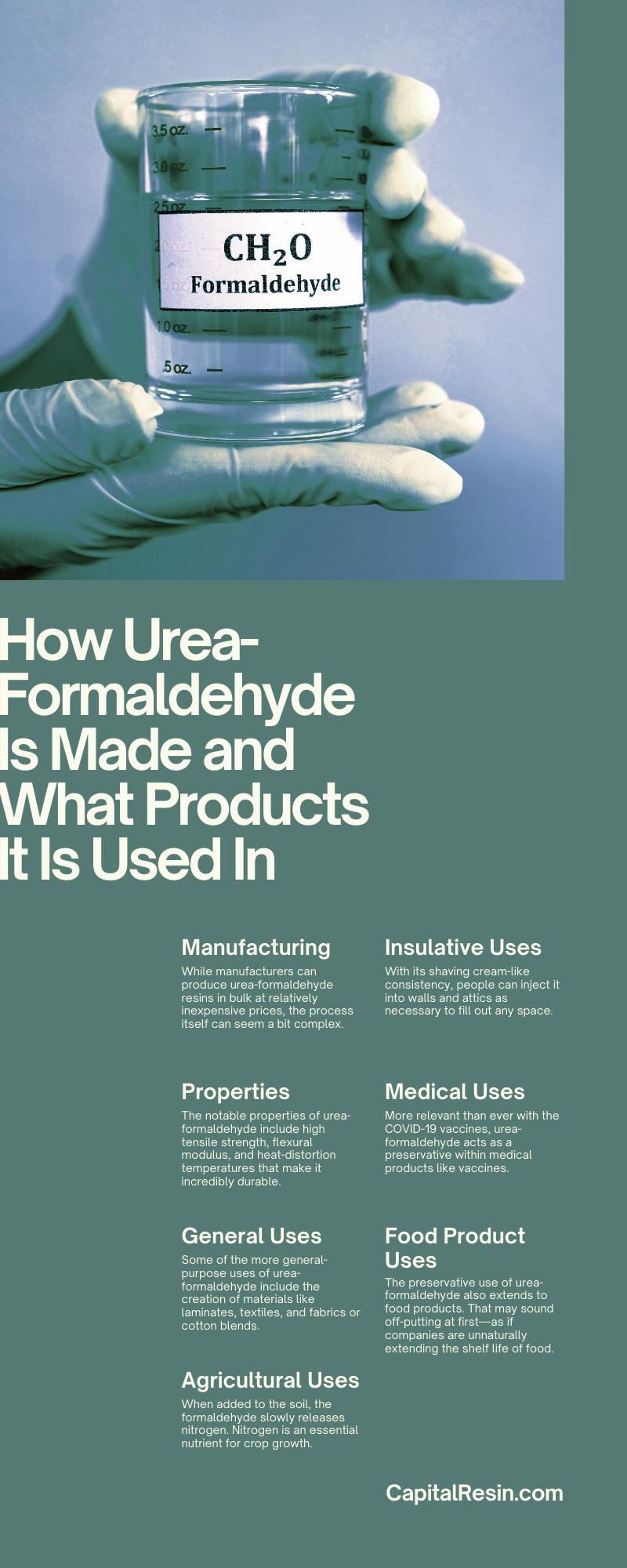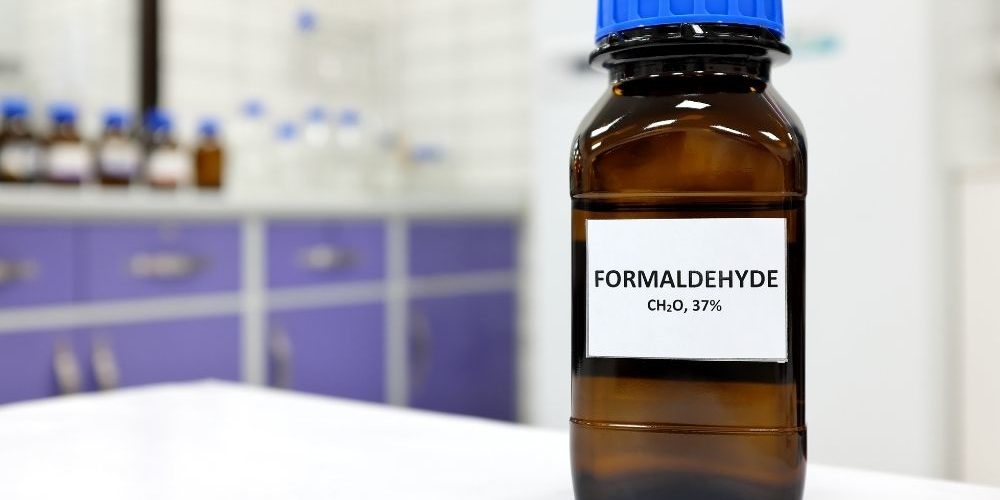Formaldehyde is an incredibly useful material that the composite industry has taken advantage of to create the majority of particle boards you may encounter in your daily life. But this is just one of the products that keep formaldehyde manufacturers in such high demand. If you would like to know more about how urea-formaldehyde is made and what products it is used in, read on for a thorough examination of this topic.
Manufacturing Urea-Formaldehyde
While manufacturers can produce urea-formaldehyde resins in bulk at relatively inexpensive prices, the process itself can seem a bit complex. They started by creating urea with carbon dioxide and ammonia at a temperature between 135 to 200 degrees Celsius and a pressure of 70 to 230 atmospheres. They then manufacture formaldehyde through the oxidation of methanol they produce by reacting carbon dioxide with hydrogen or extracting it from petroleum. Petroleum is the form that gasoline exists in before people refine it into usable gas.
When the urea and formaldehyde come together, branched and linear polymers and three-dimensional matrixes form within the resulting cured resin. The functionalities of the urea and formaldehyde are what lead to the formation of these structures. Urea has a functionality of four due to its four replaceable hydrogen atoms, while formaldehyde has a functionality of two.
There are also factors during the manufacturing process that can affect the properties of the final product. These influences are:
- The relative molarities
- The reactants
- The Reaction temperature
- The pH levels at which the condensation takes place
Taking these into account allows manufacturers to influence the resin’s molecular weight. This causes the reaction products to vary widely depending on the criteria of the reaction. Other properties that change alongside the molecular weight include solubility, viscosity, water retention, and how quickly the resin cures.
Reactions of Urea-Formaldehyde
The reaction of urea and formaldehyde exists in two stages. The first part is alkaline condensation, which forms mono-, di-, and trimethylolureas. This same reaction also produces another type of byproduct called cyclic derivatives. Examples of these are uron, monomethyloluron, and dimethyloluron.
The second stage is the acid condensation of the methylolureas to form soluble and then insoluble cross-linked resins. During acid condensation, a byproduct of low molecular weight methylene ureas emerges as a precipitate from an aqueous solution of urea and formaldehyde or methylolureas. The methylene ureas contain methylol end groups. In some cases, that makes it possible to continue the hardening process. The monomethylolureas copolymerize via acid catalysis to produce polymers and then branched and cured networks.
Properties of Urea-Formaldehyde
The notable properties of urea-formaldehyde include high tensile strength, flexural modulus, and heat-distortion temperatures that make it incredibly durable. Furthermore, it has low water absorption, mold shrinkage, high surface hardness, volume resistance, and elongation at break.
However, one of the most interesting properties of urea-formaldehyde is the fact that it’s a thermosetting material. This means that people can insert it into oddly shaped or tight spaces as a malleable material comparable to shaving cream. Through the application of heat, the material will harden into a sturdy solid and cure within a matter of weeks.
General Uses of Urea-Formaldehyde
Now that you understand how urea-formaldehyde is made, we can look at what products it is used in. Some of the more general-purpose uses of urea-formaldehyde include the creation of materials like laminates, textiles, and fabrics or cotton blends. These are everyday materials that we encounter in regular life. Urea-formaldehyde is also vital as a coating for electrical appliances like desk lamps.
Agricultural Uses of Urea-Formaldehyde
The agriculture industry has found urea-formaldehyde to be incredibly useful in fertilizing crops. When added to the soil, the formaldehyde slowly releases nitrogen. Nitrogen is an essential nutrient for crop growth. With the consistent release of nitrogen, crops become healthier and more bountiful than they would be if you grew them in soil without an abundance of nutrition.
It’s also possible to tailor the release of nitrogen depending on the soil’s microbial activity and the environmental temperature. Typically, the ideal temperature for the optimal nitrogen release lies between 21 and 32 degrees Celsius.
Insulative Uses of Urea-Formaldehyde
As previously touched upon, urea-formaldehyde contains unique thermosetting properties that allow it to fit into oddly shaped and cramped spaces. This not only provides adhesive for particle boards; it also makes the substance ideal for creating insulation within homes. With its shaving cream-like consistency, people can inject it into walls and attics as necessary to fill out any space. Once the spaces are full, heat applied to the urea-formaldehyde causes a reaction that begins the hardening process for the insulation. The hardening time only lasts for several minutes, and the curing process takes a few weeks to complete.
Medical Uses of Urea-Formaldehyde
More relevant than ever with the COVID-19 vaccines, urea-formaldehyde acts as a preservative within medical products like vaccines. This function of urea-formaldehyde is crucial because it inactivates the virus within the vaccine so that your body will experience and learn how to fight the disease without the disease actually taking hold and causing illness. Additionally, urea-formaldehyde detoxifies bacterial toxins to create safer vaccines and medical products.
Food Product Uses of Urea-Formaldehyde
The preservative use of urea-formaldehyde also extends to food products. That may sound off-putting at first—as if companies are unnaturally extending the shelf life of food. However, its actual purpose is to kill microorganisms and prevent the growth of bacteria before they can get onto the food and render it unsafe to eat. This doesn’t artificially force the food to stay “fresh” for longer. Instead, it allows the food to maintain its natural shelf life by preventing outside contaminants from infecting it and shortening the amount of time that it remains edible. Formaldehyde itself is a natural substance that every living thing produces to some degree, making it safe to consume. Moreover, it is, in fact, naturally present within fish, fruits, vegetables, meats, coffee, alcoholic beverages. So, you have nothing to fear from the use of urea-formaldehyde to keep your food safe and clean.








